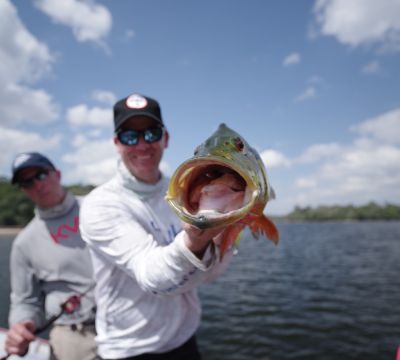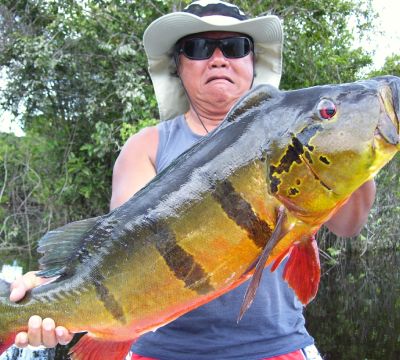Fishing Tackle & Equipment for Peacock Bass
The Amazonian Peacock Bass is the most aggressive, most tenacious, hardest fighting freshwater fish on the planet. It will hit a topwater lure with the force of a missile, tangle and shred Kevlar line, and has been known to straighten hooks. Tackling these Brazilian beasts takes nerves of steel, hard-nosed will and determination, guides with pure resolve, and, of course, the right equipment.

Captain Peacock Provides Equipment
Capt Peacock utilizes the quality and dependability of FALCON RODS & SHIMANO REELS exclusively, and all are available for guests’ use at no extra cost.
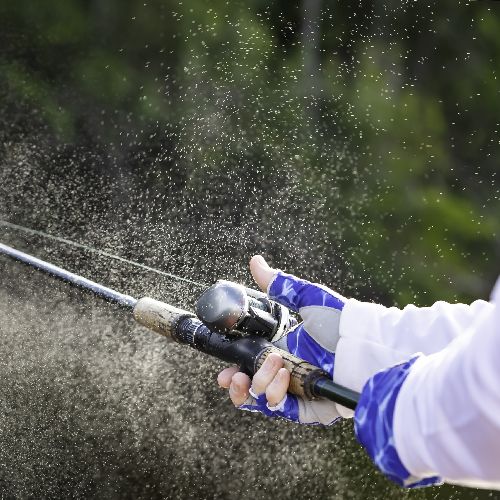
Our Rods
Our FALCON rods were designed specifically for Amazônia and each is engineered with the heavy-fighting, structure-oriented Peacock Bass in mind. We offer setups for both Bait Casting and Spinning but, given the kind of fight Peacocks generally, dish out, we highly recommend utilizing Bait Casting equipment.
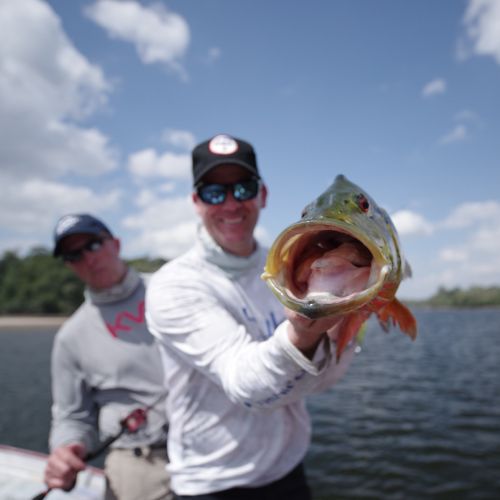
Our Reels
Our more than a decade of helping guests place Peacock Bass in Record Books has shown us that nothing tackles Brazil’s biggest and baddest like Shimano (CURADO) reels. Capt Peacock utilizes the Shimano 200E7 and 300EJ CURADO and, like all equipment, are available to guests at no extra cost.
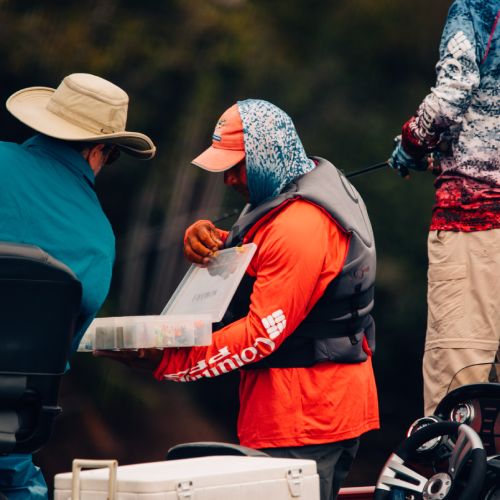
Our Lines
When you consider that an 18-pound Peacock Bass can snap 50-pound braided line with ease, you’ll see why we utilize and recommend 65 or 80 pounds braided Kevlar. Capt Peacock utilizes Power Pro and/or Spider Wire exclusively

Our Special Lure Kit
Our exclusive lure kit came as the result of our guides who have fished the Rio Negro all their lives and knew it, and it isn't inhabitants like the back of their hands. Each kit contains an UNLIMITED supply of brand-new topwater, jerk baits, and jigs. Lure Kits are included at no cost.
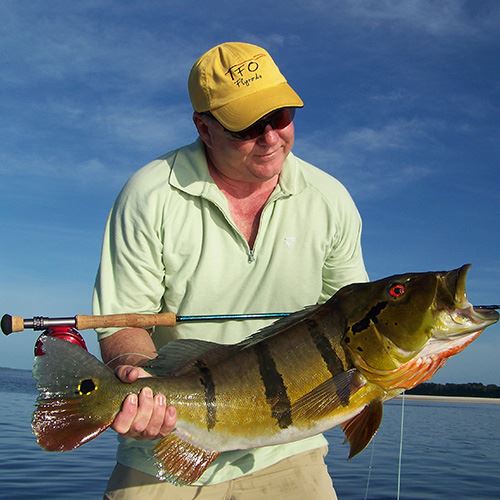
Fly-Fishing Equipment for Peacock Bass
Catching a monster Peacock Bass on a fly rod is a thrill unlike no other in life. We have 10 wt. TFO Baby Blue fly rods designed by Lefty Kreh and a limited number of TFO 375 fly reels spooled with floating and/or sinking tip fly line on board for our anglers. Recommended flies include Big streamers, Huge Bunny Leaches, Dahlberg Divers and Tarpon flies.

Amazon Fly-Fishing
For the freshwater fisherman, visualize one 15-pound Smallmouth Bass or one 25 lbs. Silver Salmon fresh from the ocean on steroids with absolutely no sense of humor, and you have an idea of what a Peacock Bass brings to the game!
It is not unusual for fishermen to bring down a 2 piece fly rod and take it home as a 4 piece rod after a week of fishing for Peacocks! These are ambush fish that will feed on a wide variety of life including baitfish, juvenile Peacocks, snakes, lizards and mostly any small wildlife that happens into their watery world. Thus, Peacock Bass can be caught on a wide variety of topwater and subsurface flies.
Heavy fly rods, high quality salt water type fly reels featuring good smooth drags, strong tippets and monster flies are the norm when fly-fishing for big Peacocks. Heavy saltwater fly equipment is the norm when fishing for Peacock Bass, if you want any chance of landing a big one. 6 – 8 inch streamers of extruded nylon tied on 3/0 – 4/0 heavy hooks are necessary as are 30 - 40 pound tippets and 9 - 11 wt. fly rods.
If you are used to using a 5 – 7 wt. fly rod with size 16 dry flies, you will quickly come to the recognition that casting with a 10 wt. fly rods while throwing huge streamers will take a toll on the body! One hook-up with a big Peacock will make you realize it was all worth it!

Fly-Fishing Rods
The majority of Peacock Bass you will catch on the fly rod will be in the 2 – 6-pound class. We had one angler catch over 150 Peacocks in the 2 – 8 lbs. class one-day fishing with a small white Bunny Leech pattern. He sized up to a 6 inches streamer fishing the same area the next day and only caught 24 fish, but three of these fish weighed 12 lbs. or better.
80% of the Peacocks you will catch, an 8 wt. rod is plenty heavy. But should you hook into a 15+ pound monster, your 8 wt. will be history! One 9 wt. rod will work for 90% of the fish, but if you hook one 20 lbs. Peacock Bass, you will have much better chance of landing it if you are using a 10 wt. rod.
For years we recommended anglers bring a 2 piece fly rod rather than a 4 piece pack rod. But with today’s technology, the 4 piece rods are plenty tough enough and much easier to travel with. High quality rods such as G-Loomis, Sage, Orvis and Temple Fork rods are worth the money if for no other reason than they have a lifetime guarantee.
Capt Peacock offers to its clients Temple Fork Outfitters fly rods for the last few for Peacock Bass. TFO rods are hard to beat! For one-third the price, complete with a lifetime guarantee, this is the rod of choice for any fly-fishermen around the globe.
Peacock Bass do not make long terrifying runs, they are structure oriented fish and fight like a Rottweiler, “right here, right now!” Once you stick them the game is trying to keep them out of the cover they live an and ambush baitfish from.
“Baby Blue” TFO rod was rated for 300-400 GR lines. This rod is a great piece of engineering, with the butt of the rod being built of S-glass for lifting power, the second and third sections being built of medium modulus graphite and the 4th section being built of high modulus graphite for the finesse of presenting the fly just where you want it! This rod teamed with the TFO375 large arbor reel with its smooth strong drag was just the ticket for any Peacock I could con into.

Fly-Fishing Reels
Fly reels are not the place to scrimp when fishing for Peacocks! You need a good quality reel, with a smooth drag and preferable and outside brake on the spool so you can palm the reel when a big fish makes its powerful runs.
Peacocks usually do not make long screaming runs like a Bone Fish or a Snook, they tend to make short very powerful runs that can be hard to control! With their abnormally large tail for their body size, they generate a huge amount of power when they turn to go.
Make sure you have 200 yds. at least 20 lbs. backing behind the fly line……just in case. When a fish gets on the reel…. It’s rodeo time!
We would strongly recommend Temple Fork Outfitter’s large arbor TFO 375 fly reel. With a large really smooth drag and lightweight for its size, this reel compliments a 10 wt. rod very well.

Fly Lines and Leaders
Saltwater fly lines and leaders are stiffer than the same weight in a fresh water line and tend to work better in the heat of the Amazon. This “stiffness” helps to roll over the big streamers you will be using, and the heat of the Amazon will not make the lines wilt.
Most fly rods will allow you to go up or down one line weight and still function well. When trying to throw 5 – 6” streamers, we also recommend you load up your fly reel with a fly line one weight heavier than the fly rod is rated for. This additional weight will help fire out and roll over the big flies you will be using. Weight forward lines like a salt-water “Tarpon Taper” or a fresh-water Pike Taper will ease your labours when throwing big flies.
You will use an intermediate sinking line for the majority of water conditions, but a sinking line is a necessity for working the points that drop off into deeper water… where the big ones live! If you plan on throwing salt-water poppers or Dahlberg Divers you will need to bring a floating line as well. When you travel as far as Brazil to play the Peacock game, you always want to take along all your weapons.
Leaders in the 30 - 50 lbs. class are the norm for fishing for Peacocks. These fish are not the least bit leader we, I’ve seen a lot of “good” fly fishermen use just a 6 or 7 ft. length of 50 or 60 lbs. fluorocarbon mono for tippet and these are the people that know what they are doing!
The old adage, “big lures for big fish,” is very true when fishing for Peacock Bass. The first time you see the big streamers used for Peacock Bass you will look at them in awe. You will catch big Peacocks on 3"streamers, but the smaller fish will normally have them long before the bigger fish have a chance to hit them.
Peacocks feed much like Black Bass and can be caught on poppers (big salt water ones are the best), Dahlberg Divers (deer hair floating frog like fly that has a slanted face that will dive a few inches below the water and make the water “gurgle” when they are retrieved, floating back to the surface when quiet), Bunny Leaches, Clousers and big Deceiver style streamers
Suggested flies for big Peacocks are huge streamers sporting big eyes and some Flash-a Bo or Tinsel in them. Finding big flies that are applicable for Peacocks can be tough. A 5 –6” streamer tied with feathers is virtually impossible to lift. from the water and false cast as they retain so much water. The best of these, what we call “Gorilla Streamers,” are tied using extruded nylon as this material sheds virtually all their water as soon as they are lifted to false cast. The extruded nylon we like to use is called Salt Water Yak Hair or Bozo Hair.
Both of these types of nylon are coarse enough to take a beating and survive catching several fish… that is unless the Piranha takes a liking to them! After using these big streamers with and without large holographic eyes, the presence of these eyes makes a big difference in a fly’s performance. Strong, quality hooks in the 3/0 – 4/0 class are also a must. Flies on 4/0 hooks, both in short shank and long shank.
Peacock Bass, although not a member of the Bass family, will feed and act a lot like a Large Mouth Bass. Think like you were fishing for largemouth bass, super-size your equipment and terminal tackle, and you will be on the right path. The big difference between the two fish is that a Peacock Bass has a red eye that does not seem to be the least bit sensitive to the sun and are active all day.
Peacock Bass actually seem to suspend during the night and do not feed. These are predatory fish and love to lie in ambush for an easy meal. Prime places to fish are around cover, not only on the banks of rivers and lakes, but also around islands, submerged trees and flooded timber, as well as sandbar points located away from the shore. Although Peacocks will school and push bait fish to the surface, the bigger fish will most often be found lying in the shadows of brush, banks or sand bars in ambush mode.
This is the main reason that heavy fly rods in the 10 wt. class are necessary when “playing” with Peacocks in the 10 – 25 lbs. class. Once a big Peacock is hooked, he will head straight for the cover he feels safe in, and will give you more fight, pound per pound than any fresh water fish you have ever hooked before on a fly rod. Peacocks have an abnormally large tail for their body size, which generates tremendous power.
A great technique is to fish a plug caster and a fly fisherman in the same boat. With the plug caster in the front of the boat, he will make enough noise to raise a big fish. When he does, the fly fisherman needs to drop his fly near the swirl of the striking fish or even right behind a fish hooked by the plug caster. Peacocks will very oft.en travel in pairs and when one fish is hooked the other fish will make attempts to steal the bait away from the hooked fish. The second fish, or a fish that has struck at the plug and missed, will readily strike the fly if he sees it. Think of the plug as the teaser behind an offshore sport fisher trolling for Sailfish or Marlin. The teaser raises the fish, and then the fish sees the baitfish or fly that you actually plan on catching the fish with.
Fishing Techniques
Peacock Bass Fishing Techniques

Peacock Bass, although not a member of the Bass family, will feed and act a lot like a Large Mouth Bass. Think like you were fishing for largemouth bass, super-size your equipment, and terminal tackle, and you will be on the right path. The big difference between these two species of fish is that a Peacock Bass has a red eye that does not seem to be the least bit sensitive to the sun, so they are active all day.
Also, Peacock Bass do not go off into deep water and sulk after they spawn; both male and females will protect their fry once the eggs hatch. Many times your guide will tell you to cast to a brushy point 8 or 10 times and you will think he is just killing time. Not true, your guide knows the type of cover big Peacock Bass like and if they are not actively feeding, they can be enticed into striking by casting to them a number of times and making them mad! Very often you will see a second Peacock trying to take the lure away from the one that has it. It can be very advantageous for the 2nd angler in the boat to cast right behind a hooked fish as it will quite often result in a double hookup.
If a fish swirls behind your lure and does not get hooked, do not stop the lure – keep it moving. Peacock Bass will very often make 2 or 3 runs at a lure before they get hooked. If you stop the lure they tend to lose interest in it. You want to move your lure quickly, be it a topwater noisemaker or a subsurface jerk bait or jig, as you are trying to instill the instinct to chase and catch the prey in the Peacock’s mind. If a noisy topwater lure like a woodchopper knockoff is not producing fish, switch to the more subtle action of a Zara Spook or a He-Dog.
The last 3 IGFA All Tackle World Record of 27, 28 (caught with Capt Peacock in Feb of 2010) and 29 lbs. have all been caught on noisy topwater lures in the main Rio Negro or within a couple of miles of the mouths of its tributaries. Fishing a ½ oz. jig will usually catch 2 to 3 times the number of fish a topwater lure will, but most often not the size.
Hen you are tired from throwing that big 1 ½ oz. topwater lure after a couple of hours, you can troll awhile. Trolling jigs or big flies will produce bone-jarring hits and will produce some big fish. You will also cover a lot of different water trolling.

Fishing Backwater Lagoons & Lakes
When the water gets really low, and the creeks dry up, the guides will sometimes take you on a walk, often pushing their boats on small logs overland to reach these now landlocked lakes. You will experience some awesome days of fishing in these backwaters, and it was quite the unforgettable adventure getting to them!
Early in the mornings you seem to see a lot of activity in the shallow edges of these small lakes and lagoons as the bigger Peacock Bass are chasing baitfish and juvenile members of their species. As the day goes on and the water in the shallows heats up, the bigger Peacock Bass do tend to move into the deeper water in the middle of the lagoons where the water is a little cooler. Thus, generally you will fish the shallow edges in the mornings and the deeper waters during the heat of the day.
Peacock Bass actually seem to suspend during the night and do not feed. Peacock Bass are predatory fish and love to lie in ambush for an easy meal. Prime places to fish are around cover, not only on the banks of rivers and lakes, but also around islands, submerged trees and flooded timber, as well as sandbar points located away from the shore. Although Peacock Bass will school and push bait fish to the surface, the bigger fish will most often be found lying in the shadows of brush, banks or sand bars in ambush mode.
The places you will look for in pursuit of big Peacock Bass (10 lbs. +) are points with submerged brush on them that drop into 8 – 15 feet of water. Points that drop off into 3 – 8 feet of water will usually hold smaller fish, except in the mornings. The exception to this rule is when the Peacock Bass are spawning around the sand bars located in the backwaters. Remember, the biggest fish will hold the most advantageous ambush sights, i.e.; points, stumps, etc. This is the main reason that heavy fly rods in the 10 weight class are necessary when “playing” with Peacock Bass in the 14 – 25 lbs. class and the use of the 65 – 80 lbs. test braided Kevlar on the bait casting and spinning gear.
Once a big Peacock Bass is hooked, he will head straight for the cover he feels safe in, and will give you more fight per pound than any fresh water fish you have ever hooked before. Peacock Bass have an abnormally large tail for their body size, which generates tremendous power. Do not overlook a solitary stickup, no matter how small, in the middle of a lagoon. Very often a big Peacock Bass will be holed up in its shadow in ambush mode. Cast to it, work you lure past the stickup and be sure you have a good grip on your rod!

Fishing the Main River Channels
The old saying goes, “big waters mean big fish,” and this holds true for Peacock Bass in Brazil’s Amazon.
Some outfitters will tell you it is necessary to fly into remote stretches of the tributaries of the Rio Negro, “away from everyone and everything,” to catch a big Peacock Bass. But looking at the IGFA record books shows this is simply not true.
Peacock Bass are an extremely aggressive predatory species that will eat most anything they can get in their mouth. They will feed on a wide variety of bait fish, including juvenile members of their own species, small snakes, birds and mice that have found their way into the water as well as insects and terrestrials that are available to them.
The mitigating factor in having a successful Peacock Bass fishing trip in South America’s rain forest is the level of the water. Even though we fish during the dry season, from late August to late March, they do not call it the “Rainforest” for no good reason. The river systems in the Amazon are so vast that, even though it may not have rained in your local area for several weeks, the water can suddenly come up a foot or two because it has rained 100 – 200 miles upriver recently. This makes the ability to move to a river system that is experiencing ideal water conditions as the key feature in experiencing a successful Peacock Bass fishing trip.
During low water conditions the Peacocks concentrate around river points and structure near the banks and in backwater lagoons as well as around sandbars and submerged structure in the main river channels. These types of low water conditions concentrate the Peacocks as the number of prime ambush areas is greatly reduced. If the water gets too low, it dries up the little outlets of the backwater lagoons and denies the angler accessibility to these areas. When the water levels go up and the rivers get out of the banks the Peacock Bass are presented with a new food source and will quickly move from their current habitat in the main rivers into the flooded land to feed on insects, lizards and the small baitfish that stay in shallow water for protection from their predators.
Fixed base operations can produce good fishing…when the water conditions are ideal in that particular region. Mobility is the key to success of this type of fishing as fishing a given area hard day after day, week after week, educates the fish and reduces the quality of fishing over a 6 (six) months fishing season.
Our yacht, which acts as the mother ship, tows twelve 18 foot American Tracker Bass Boats, equipped with 60HP - 4 stroke outboard motors, trolling motors, VHF long range radios ensuring safety, comfort, and a short run to the best fishing areas daily.


